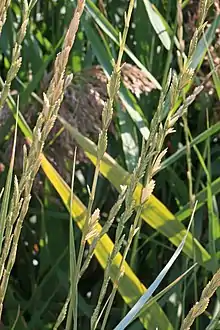Thinopyrum ponticum
Thinopyrum ponticum is a species of grass known by the common names tall wheatgrass,[1] rush wheatgrass, and Eurasian quackgrass. It is native to Eurasia and it has been introduced to many other parts of the world, including much of the Americas and Australia.[2]
| Thinopyrum ponticum | |
|---|---|
 | |
| Scientific classification | |
| Kingdom: | Plantae |
| Clade: | Tracheophytes |
| Clade: | Angiosperms |
| Clade: | Monocots |
| Clade: | Commelinids |
| Order: | Poales |
| Family: | Poaceae |
| Subfamily: | Pooideae |
| Genus: | Thinopyrum |
| Species: | T. ponticum |
| Binomial name | |
| Thinopyrum ponticum (Podp.) Z.-W.Liu & R.-C.Wang | |
| SynonymsUSDA—NRCS[1] | |
| |
This perennial bunchgrass can grow up to 2 meters tall. The ribbed leaves have pale green blades a few millimeters wide. The inflorescence is a spike studded with spikelets up to 3 centimeters long, each containing up to 12 flowers.[3]
This grass is used as a forage and for hay in many places.[4] It is good for land with saline soils, and it can help reduce the salinity. It is also good for non-saline soils.[5] This grass is commonly crossed with its relative, wheat, in order to give the wheat traits such as stress tolerance and pest resistance.[6][7]
Head Blight Resistance
Thinopyrum ponticum is resistant to Fusarium head blight, which is caused by Fusarium graminearum. This is due, in part, to the Fhb7 gene. The protein product of the Fhb7 gene detoxifies trichothecenes produced by the fungus, which harm both the plant and any mammals that consume them. Evidence suggests that the Fhb7 gene was acquired from an Epichloë fungus by horizontal gene transfer.[8] The Fhb7 gene has been introgressed into wheat.
References
- "Thinopyrum ponticum". Natural Resources Conservation Service PLANTS Database. USDA. Retrieved 9 December 2015.
- "Thinopyrum ponticum". Germplasm Resources Information Network (GRIN). Agricultural Research Service (ARS), United States Department of Agriculture (USDA). Retrieved 25 January 2018.
- Thinopyrum ponticum. Archived 2012-10-20 at the Wayback Machine Grass Manual Treatment.
- Thinopyrum ponticum. USDA NRCS Plant Guide.
- Tall wheat grass. Western Australia Department of Agriculture and Food.
- Oliver RE, Xu SS, Stack RW, Friesen TL, Jin Y, Cai X. (2006). "Molecular cytogenetic characterization of four partial wheat–Thinopyrum ponticum amphiploids and their reactions to Fusarium head blight, tan spot, and Stagonospora nodorum blotch" (PDF). Theor Appl Genet. 112 (8): 1473–9. doi:10.1007/s00122-006-0250-1. PMID 16544125.CS1 maint: uses authors parameter (link)
- Chen G, Zheng Q, Bao Y, Liu S, Wang H, Li X. (2012). "Molecular cytogenetic identification of a novel dwarf wheat line with introgressed Thinopyrum ponticum chromatin". J Biosci. 37 (1): 149–55. doi:10.1007/s12038-011-9175-1. PMID 22357212.CS1 maint: uses authors parameter (link)
- Wang H, Sun S, Ge W, Zhao L, Hou B, Wang K, Lyu Z, Chen L, Xu S, Guo J, Li M, Su P, Li X, Wang G, Bo C, Fang X, Zhuang W, Cheng X, Wu J, Dong L, Chen W, Li W, Xiao G, Zhao J, Hao Y, Xu Y, Gao Y, Liu W, Liu Y, Yin H, Li J, Li X, Zhao Y, Wang X, Ni F, Ma X, Li A, Xu SS, Bai G, Nevo E, Gao C, Ohm H, Kong L. (2020). "Horizontal Gene Transfer of Fhb7 From Fungus Underlies Fusarium Head Blight Resistance in Wheat". Science. 368 (6493): eaba5435. doi:10.1126/science.aba5435. PMID 32273397.CS1 maint: uses authors parameter (link)
| Wikimedia Commons has media related to Thinopyrum ponticum. |